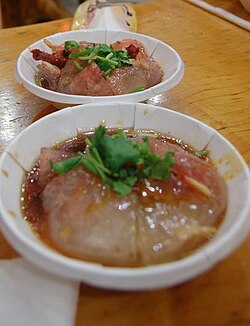Taiwanese street food This article is about a Taiwanese street food. For the populated place in India, see Bawan.
| This article includes a list of general references, but it lacks sufficient corresponding inline citations. Please help to improve this article by introducing more precise citations. (March 2016) (Learn how and when to remove this message) |
 | |
| Type | Dumpling |
|---|---|
| Course | Dim sum |
| Place of origin | Taiwan |
| Main ingredients | Dough (corn starch, sweet potato starch, rice flour), pork, chicken, bamboo shoots, shiitake mushrooms |
| Bah-oân | |||||||||||
|---|---|---|---|---|---|---|---|---|---|---|---|
| Traditional Chinese | 肉圓 | ||||||||||
| Literal meaning | meat circle | ||||||||||
| |||||||||||
Bah-oân (Chinese: 肉圓; pinyin: ròuyuán; Wade–Giles: jou-yüan; Pe̍h-ōe-jī: bah-oân; lit. 'meat circle') is a Taiwanese street food.
Name
The term "ba-wan" is a non-standard romanization derived from Taiwanese Hokkien. In the township of Lukang, Changhua County, ba-wan are known as bahhoe (肉回; ròuhuí; bah-hôe; 'meat return') because they take on the block-like shape of the character 回.
History
It is believed that ba-wan were first prepared in the Beidou township of Changhua County by a scribe by the name of Fan Wan-chu (范萬居; Fàn Wànjū) as food for disaster relief, when the region was struck by heavy floods in 1898. Since then, ba-wan has spread to different regions of Taiwan and is now considered by many as a national food, and can be found in most night markets in Taiwan. The traditional wrapper was made with sweet potato starch alone, sweet potatoes were the dominant food crop in pre-1950s Taiwan and were traditionally preserved by extracting their starch. The ingredients of the ba-wan reflect the terroir of Taiwan.
Production
The ba-wan is a disk-shaped translucent dough 6–8 cm (2.4–3.1 in) diameter made of sweet potato starch filled with savory stuffing and served with sweet and savory sauce. The stuffing varies widely according to different regions in Taiwan, but usually consists of a mixture of pork, bamboo shoots, and shiitake mushrooms. Changhua-style ba-wan is considered to be the "standard" ba-wan as it is the most famous and most widely imitated of all styles of ba-wan.
The gelatinous dough is made of a combination of corn starch, sweet potato starch, and rice flour, which gives it its chewy, sticky, and gelatinous texture (sometimes described as "Q" in Taiwanese parlance) and a greyish translucent hue. Ba-wan are initially cooked by steaming; however, they may also be served after being deep fried to give them a "skin" or gently poached in oil to heat them without drying them out. Their form makes them relatively easy to pre-make and store. They can be quickly heated again in oil before serving.
See also
References
- Han Cheung (5 August 2018). "Taiwan in Time: Deadly waters and their legends". Taipei Times. Retrieved 5 August 2018.
- ^ Wei, Clarissa. "The Giant Jiggly Crystal Meatball Is the Ultimate Taiwanese Snack". eater.com. Eater. Retrieved 18 May 2023.
- Behnke, A. (2007). Taiwan in Pictures. Visual Geography (Lerner) Series. Twenty-First Century Books. p. 53. ISBN 978-0-8225-7148-3. Retrieved 5 November 2016.
- Wong, Maggie Hiufu (24 July 2015). "40 Taiwanese foods we can't live without". CNN. Retrieved 5 November 2016.
- "A beginner's guide to Taiwanese food in London: the best restaurants". Evening Standard. 6 May 2015. Retrieved 5 November 2016.
- "For Taiwanese Americans, There's No Better Texture Than Q". KQED. Retrieved 2021-12-15.
- 林明德 (2002). 彰化縣飲食文化 (in Chinese). Changhua City: Changhua County Cultural Affairs Bureau. ISBN 9789570101263.
